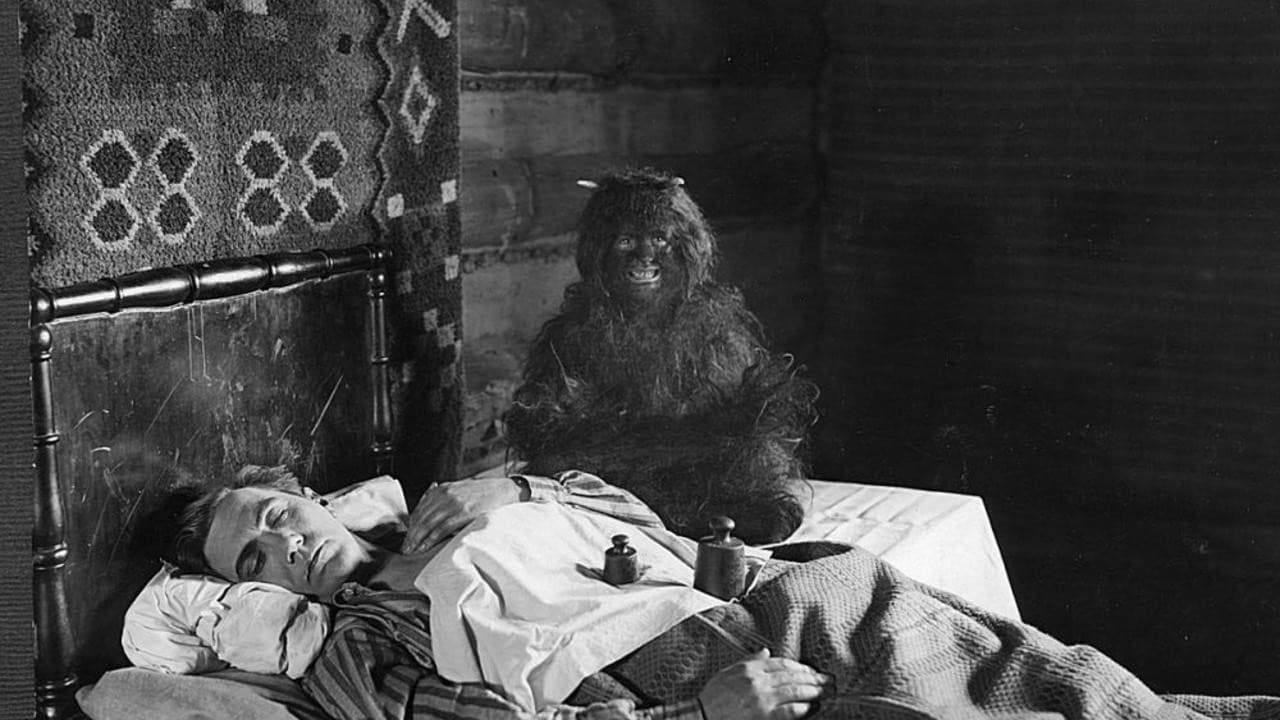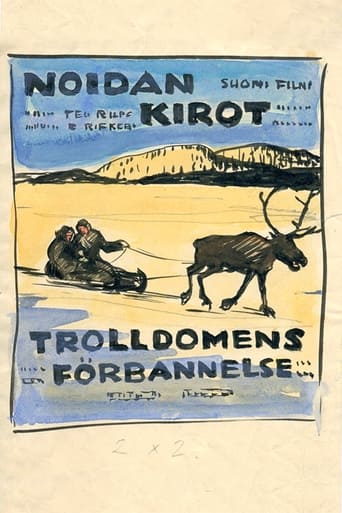

Frau Selma und Herr Simo are a young couple of newly-weds who are on a long travel far North to their new home in Utuniemi. There waiting for them is Herr Simo's sister, Frau Elsa who had become blind when she was a child. In surrounding Utuniemi work some lumbermen; they're rough people who Herr Simo doesn't like at all.When Frau Simo is visiting his parents-in-law, Frau Elsa tells Frau Selma a strange story about a witch from Lapland who lived in Utuniemi called Jantukka. Jantukka created much harm for the Finns. During a terrible battle and before the witch was murdered, he cursed all the people in Utuniemi so that henceforth their offspring will be blind. That's precisely the reason of Frau Elsa's blindness.But during Herr Simo's absence a terrible incident will happen. When Selma is checking their fishing nets in the lake of Veksalahti, three lumbermen led by one called Fat Sakar, take advantage of the helpless woman "Noidan Kirot" ( The Curse Of The Witch ) was directed by Herr Teuvo Puro in the silent year of 1927 and is considered in the country of the thousand lakes as the first Finnish horror film. It's a picture that was based on a novel by Herr Väinö Kataja about the Lappland region and the old superstitions of the people who lived there.The film is certainly very interesting, subtle and appalling for Finns or German counts, for the old stories, curses, witches and the sibylline doomed atmosphere that is depicted in the film.Herr Puro combines wisely the old superstitions of the region ( old stories of ancient times, intangible but vivid after so many years ) with contemporary menaces represented in the lumbermen. These latter are real and very dangerous, an interesting metaphor, ja wohl! Thus is combined what it is a matter of belief about superstitions of the past, with the real presence of the lumbermen in the beautiful place of Utuniemi...and these nowadays sorcerer's apprentices.In "Noidan Kirot" the Finnish environment shines at its best ( beautiful landscapes in where the hard daily life is depicted ) and the lumbermen violence and threats ( dark in what is supposed to be an idyllic place). It's combined together with Kantuka's cursing ( Herr Puro use double exposures and some camera movement in order to emphasize such unhealthy atmosphere ) in creating a subtle and disturbing atmosphere. In this background, the seeds of evil around Utuniemi finally will give birth in Frau Selma's first-born, a disorderly infant that revives terrible memories for the young couple.And that's certainly Herr Puro's achievement... to make a horror / fantasy film with elements of the past but setting these in a modern context. He chooses the largest and northernmost of the regions of Finland as the locale to hide ancient superstitions. Our hero will have finally the chance to avenge and redeem his family cursed fate ( from the past or the present) in a oeuvre with a thrilling film narrative. It's a disturbing and original picture in where the inner and primal fears together with the primitive and evil instincts of men, are the true main characters of the film.And now, if you'll allow me, I must temporarily take my leave because this German Count must curse some of his undisciplined servants.
... View MoreFinnish cinema has not traditionally been known for horror films but is not devoid of examples of the genre either. Movies like Valkoinen peura (1952) and Noita palaa elämään (1952) still retain at least some of their original power and recent titles like Sauna (2008) and Dark Floors (2008) have received attention abroad as well. From a modern perspective it is very interesting to see the very first Finnish horror film Noidan kirot from 1927 – how well is the terror conveyed through the means of silent cinema?Like Valkoinen peura, Noidan kirot is set in the wilderness of Finnish Lapland. The story begins when a young man Simo (Einar Rinne) brings his newlywed wife Selma (Heidi Blåfield) to his remote farm called Utuniemi to live happily with him and his blind sister Elsa (Kaisu Leppänen). However, he has to spend long periods of time away from home and during his absence Elsa tells Selma about the old legend of a powerful Sami shaman who once lived in the area and placed a curse on the local people before his violent death. Soon Elsa falls deliriously ill and Selma starts having visions of the witch too. Things are not helped by the fact that a local brute named Fat-Sakari (Yrjö Tuominen) has laid his eyes on the defenseless Selma.Sadly, the horror elements soon become secondary to the drama plot about sexual morality, suspicion, guilt and justice. Sure, there is nothing wrong with such themes per se but frankly, they have been done to death in later films and just cannot feel very fresh anymore even if they did in 1927, although this is not really the movie's fault. Some of the wintry scenery, the visions of the shaman and a brief flash of a hairy demon causing nightmares to Simo look cool though; I wish the supernatural elements were more prominent because the movie would clearly have had potential for more than an ordinary melodrama.It is of course very exciting to see authentic Finnish silent films regardless of their cinematic quality, but as a narrative tale Noidan kirot does not work as powerfully as the true masterpieces of the genre. The constant use of verbose intertitles to describe not only dialogue but also the surroundings feels excessive and the larger-than-life acting comes across as more comical than dramatic, especially with Einar Rinne in the lead role. Nonetheless, as a fan of 1920s film starlets I did like the fragile Heidi Blåfield in the role of Selma and the black-eyed Kaisu Leppänen as the sickly Elsa. The highly dramatic music composed by Tapio Tuomela for the 2010 re-release sounds pretty good and helps the film significantly by filling in moods where the images don't always succeed. Visually the movie is rather psychedelic; instead of regular black and white, the screen is always tinted with bright colours like yellow, green, blue, red and even pink or purple at least in the version I saw.It goes without saying that Noidan kirot is a must-see for cinephiles interested in the history of Finnish cinema, but judging solely from its inherent merits, it left me somewhat cold much like director Teuvo Puro's earlier film Ollin oppivuodet (1920) that is also a part of The Finnish Broadcasting Company's project of re-scoring old Finnish silents. As a curiosity the movie can certainly be recommended to horror buffs though and Tapio Tuomela's score can be easily appreciated by film music aficionados, so ultimately Noidan kirot is not a worthless effort by any means. Still, to me it is a film to be appreciated more than liked.
... View More